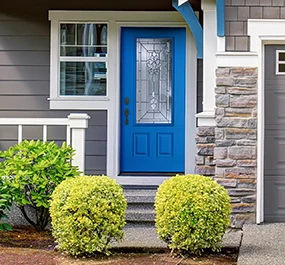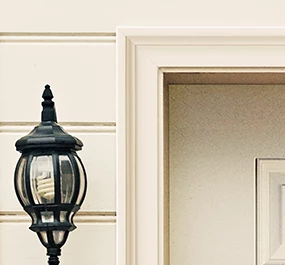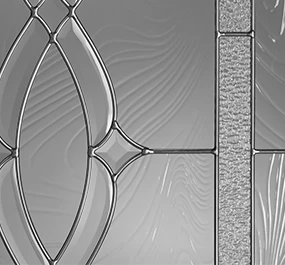There are a variety of materials to consider when selecting an entry door, and each type differs when it comes to appearance, cost, sustainability, and more. For years, wood entry doors were really the only choice, but with innovations in the past 30 years, steel and fiberglass entry doors have become real contenders. Choosing between these three options is an important decision with long-term consequences for preventing waste and avoiding expensive replacements. Read on to see how these materials compare and which have the best potential to stand the test of time.
1. Appearance
Wood entry doors are known for being visually appealing, traditional, and easily customizable. Their rich, natural color often makes them an attractive buy. Additionally, they are available in several configurations and sizes- they are more easily customized in width and height than steel and fiberglass doors.
Steel doors, on the other hand, are widely considered the least adaptable. Most steel doors feature a smooth surface and less available configurations, resulting in minimal curb appeal compared to wood and fiberglass.
Fiberglass doors offer the best of both worlds and act as a good compromise between wood and steel. These doors have evolved to mimic the look of wood graining, and come in various styles that can be stained or painted depending on the skin to suit homeowner preference.
2. Cost and Durability
Price is a major factor in deciding which option to invest in. Both the upfront cost of the material and the cost-per-use of the door should be considered.
Wood doors typically start at a higher price point than steel or fiberglass, but the pricing will vary depending on the type of wood and slab sizes. However, wood doors are highly susceptible to weather and are privy to scratches, dents, warping, and moisture damage which will likely necessitate a full, costly replacement.
Basic steel doors are the lowest initial cost, but also the most susceptible to damage in the long-term- the material is very prone to denting and rusting. What’s particularly bothersome about steel entry doors is how easily they can be damaged during installation and construction; they don’t stand up well to the abuse generated on jobsites. And this material is the hardest to repair and most likely to require a full door replacement.
Fiberglass entry doors typically offer a mid-price point, although more elaborate configurations will increase the cost. But what fiberglass doors cost upfront, they make up for with their durability.
With a composite exterior that repels water and resists warping, rotting, and cosmetic damage, fiberglass doors should last decades with minimal maintenance. This makes them an excellent investment and a natural choice for consumers seeking sustainable building materials. The longer lifecycle of the material reduces waste and the resources needed for manufacturing.
3. Energy Efficiency
Energy efficient exterior doors help reduce energy usage and costs in the home, so this is another important factor to consider when determining the pros and cons of wood, fiberglass, and steel entry doors.
Wood doors have relatively poor insulation and are the least energy efficient option. Natural wood is more likely to disperse heat from the indoors to the outside and vice versa than steel or fiberglass.
Steel doors are more energy efficient than wood, and can also outperform fiberglass when made properly and filled with high-density, polyurethane foam. However, steel is the strongest temperature conductor, meaning that it is most likely to be affected by the weather. The door can be extremely cold in the winter as well as burning hot in the summer— and this will extend indoors if not built properly.
However, even though some steel doors will outperform fiberglass in regards to U-Factor and R-Value, fiberglass doors are still top-rated when it comes to energy efficiency. Like steel doors, when their foam cores are tightly packed, they provide strong insulation and help maintain a consistent temperature, which ultimately will lower energy usage in any season.
In conclusion, fiberglass doors may be worth the investment due to the combination of their beauty, design, and function, especially when considering the savings on energy and replacement costs. This might sound too good to be true, and with some brands that is certainly the case. Fiberglass doors built with exposed wood components will fail if not properly cared for. So, when choosing a fiberglass door, look for brands, like Plastpro, that sell fiberglass doors with a completely composite exterior and a complementary composite door frame, to make sure you can fully experience the benefits of an all-composite entry unit for your project.



